Diagnosing a false alarm in a temperature transmitter connected to a PLC will typically follow these steps:
Check the PLC programming
Sometimes, the false alarm could be due to an error in the PLC’s programming. The logic in the PLC should be thoroughly examined to ensure it’s correctly written and configured to interpret the signals from the temperature transmitter correctly.
Verify the temperature reading in real-time
Monitor the temperature reading on the PLC interface. If it’s fluctuating erratically or showing an unusually high or low temperature, it could be a signal issue, a sensor fault, or an actual temperature anomaly.
Inspect the temperature sensor
The problem might be with the temperature sensor itself. The sensor could be damaged, incorrectly installed, or influenced by surrounding conditions. Manual inspection and testing could help identify such issues.
Cross-check with other sensors
If you have other temperature sensors in the same area or system, compare their readings. If only one sensor is giving a high reading, it might be a false alarm. However, this might not be foolproof, as the other sensors could also be malfunctioning or their area of measurement might not be experiencing the same temperature change.
Check the sensor wiring and connections
Issues like loose connections, corrosion, or wire damage could cause incorrect temperature readings. Carefully inspect all the wiring from the temperature transmitter to the PLC.
Conduct a loop test
A 4-20mA loop test can be performed to ensure the transmitter and the PLC are communicating correctly. This involves injecting a known current into the transmitter and seeing if the PLC reads it correctly.
Replace the sensor (if necessary)
If all the above checks are done and the false alarm persists, you might have to replace the temperature transmitter. After replacement, monitor the system closely to ensure the problem is solved.
Each case is unique and the steps can vary based on the specific PLC system, the temperature transmitter model, and the environment in which they operate. This is why it’s crucial to maintain a thorough understanding of your specific system, and also why professional help is recommended for complex issues
